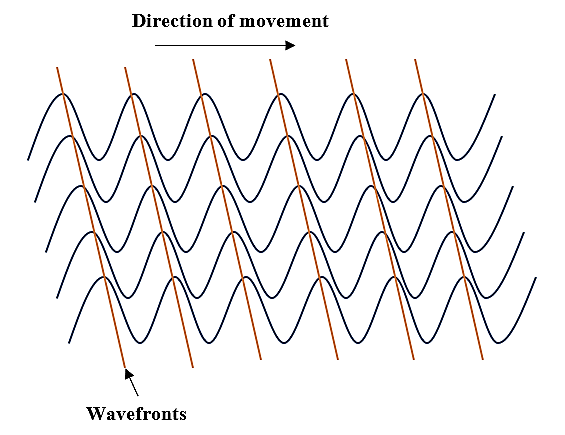
What is the wavefront of light waves?
Answer
453.9k+ views
Hint: When a wave is generated from a source, it starts travelling in a particular direction. Different points of the wave have different phases. The continuous locus of all the points having the same phase is known as a wavefront. The perpendicular line drawn from at any point on the wavefront represents the direction of the propagation of the wave at that point.
Complete solution:

Wave front is a surface or line in the path of a wave motion on which the disturbances at every point have the same phase. The sum of rays passing through a surface produces or creates a wavefront. The wavefront surface is always perpendicular to the ray which denotes the direction of the propagation of the light wave. Wavefronts travel with the speed of light in all directions in an isotropic medium. Depending on the source of light, there can be three types of wave fronts:
1) Spherical wavefront
2) Plane wavefront
3) Cylindrical wavefront
When the identical waves having a common origin travel through a homogeneous medium, the corresponding troughs and crests are in phase at any instant.
Thus, the wavefront of light waves is the imaginary surface representing corresponding points of a light wave that vibrate in the same phase.
Note:
Students must remember although the wavefront has a definite direction of propagation, it is not a vector quantity. It is a time varying function which denotes a surface. The nature of the wavefront depends on the nature of the source through which light is produced. For parallel rays, the wavefront is a plane surface. Whereas for diverging or converging rays, the wavefront is spherical. If the source is distributed by the slit then the wavefront will be cylindrical.
Complete solution:

Wave front is a surface or line in the path of a wave motion on which the disturbances at every point have the same phase. The sum of rays passing through a surface produces or creates a wavefront. The wavefront surface is always perpendicular to the ray which denotes the direction of the propagation of the light wave. Wavefronts travel with the speed of light in all directions in an isotropic medium. Depending on the source of light, there can be three types of wave fronts:
1) Spherical wavefront
2) Plane wavefront
3) Cylindrical wavefront
When the identical waves having a common origin travel through a homogeneous medium, the corresponding troughs and crests are in phase at any instant.
Thus, the wavefront of light waves is the imaginary surface representing corresponding points of a light wave that vibrate in the same phase.
Note:
Students must remember although the wavefront has a definite direction of propagation, it is not a vector quantity. It is a time varying function which denotes a surface. The nature of the wavefront depends on the nature of the source through which light is produced. For parallel rays, the wavefront is a plane surface. Whereas for diverging or converging rays, the wavefront is spherical. If the source is distributed by the slit then the wavefront will be cylindrical.
Recently Updated Pages
Using the following information to help you answer class 12 chemistry CBSE

Basicity of sulphurous acid and sulphuric acid are

Master Class 12 Economics: Engaging Questions & Answers for Success

Master Class 12 Maths: Engaging Questions & Answers for Success

Master Class 12 Biology: Engaging Questions & Answers for Success

Master Class 12 Physics: Engaging Questions & Answers for Success

Trending doubts
What is the Full Form of PVC, PET, HDPE, LDPE, PP and PS ?

Figure shows a conducting loop ABCDA placed in a uniform class 12 physics CBSE

Explain with a neat labelled diagram the TS of mammalian class 12 biology CBSE

The first general election of Lok Sabha was held in class 12 social science CBSE

How do you convert from joules to electron volts class 12 physics CBSE

The term ecosystem was coined by a EP Odum b AG Tansley class 12 biology CBSE




